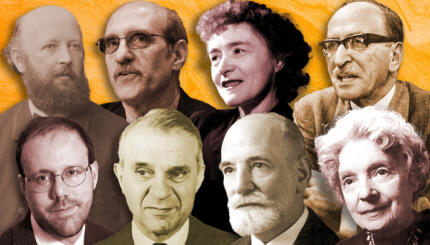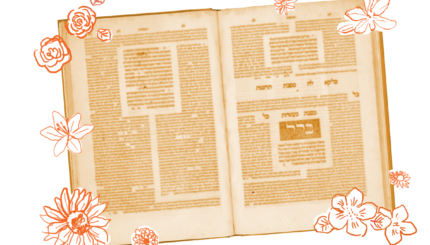The family has always been central to Jewish life and culture. Recent demographic changes in the Jewish community and changing social realities and norms have challenged traditional ideas of what a family is, and in the following opinion piece, the author argues that the Jewish community needs to address the new realities of the Jewish family frankly. Reprinted with permission from Sh’ma magazine.
Our understanding of the Jewish family is furthered more by the text of the Torah than by the myths of the 1950s. We are far closer to our biblical roots in terms of family structure than we are to “Leave It to Beaver” or “The Cosby Show.” Thinking about the Jewish family and adjusting our organizational and institutional network will require letting go of a romanticized view of the Jewish family that never existed.
When most people close their eyes and conjure up an image of a Jewish family, they are most likely to see a man and a woman married to each other for the first time with biological children that belong to both of them, where both spouses are Jewish and at least somewhat involved, if not actively involved, in Jewish life. They tend not to see divorce and remarriage, gay or lesbian families, singles, non-Jewish spouses, or partners living together without marriage. That is just for starters. They certainly do not imagine all of the pathologies and dysfunction that plague American families in general, and have troubled families since the institution of “family” was created biological eons ago.
Pathology: A Part of Life
And yet, pathology has always been a part of family life in general, and Jewish family life in particular. The stories of Genesis are filled with fraternal murder, jealousy, incest, polygamy, and child abuse. Jewish families can be filled with nurturing and love, cohesiveness and trust, and stability and joy. They can also be filled with fear, sorrow, disappointment, hatred, and violence. The Jewish family is a reflection of the human condition–no more, no less.
Looking to the future of the Jewish family, the following realities must be addressed by the Jewish organizational and institutional network. First, the extended family is largely inoperative for many Jews. Grandparents have scattered to the Sunbelt and siblings live all over the country. Anyone who has tried to arrange a Passoverseder for the entire family knows how challenging the geographic distance has become. The loss of extended family for many is profound. Jewish organizations and institutions must fill the breach, offering a communal substitute for the extended family. This requires human and financial resources, and a warmth and sensitivity that is often lacking in our communal structure.
Second, Judaism is not the primary identity for most American Jews. It is part of who they are; it is important to be a Jew, but it does not drive their lives. They are also doctors, golfers, environmentalists, and a host of other identities. As much as many Jewish communal leaders would like Judaism to be the prime identity, it is not likely to be so for most American Jews in the immediate or even distant future. This means that Jewish organizations and institutions have to meet Jewish families where they are, rather than bemoaning who they are not.
Redefining Family
Third, Jewish families are no longer defined by blood. Indeed, neither are individuals. A growing number of Jews formally convert, and many individuals live as Jews without formal conversion. Growing numbers of Jews are adopted, and significant numbers of non-Jews are “fellow travelers” connected to the Jewish family through mixed marriage. Jewish bloodlines will matter less and less, and clinging to matrilineal (or even patrilineal) descent–that is, being the birth child of a Jewish mother (or father) who herself was the birth child of another Jewish mother–will have less and less applicability and relevance as the Jewish community moves forward. The whole controversy about patrilineal or matrilineal descent will have less currency as the Jewish family becomes increasingly defined by those who choose to be part of the Jewish people rather than those who were born into this identity.
Fourth, families are diverse: by race, religion, sexual preference, and a myriad of other factors. Jews are increasingly Black, Asian, Latino, and multiracial; they come from Protestant, Catholic, and other religious backgrounds; they are married, divorced, single, and partnered; significant numbers are gay and lesbian. Many individuals may now be single longer than they are married during their lifetime. The American image of Jews as either central or eastern European, largely Ashkenazic descendants from Fiddler on the Roof does not reflect the complexity of the American Jewish family.
Those who are subject to nostalgia often long for some particular time and place, and associate it with some particular mythology of “how life used to be.” Moreover, the Jewish community as a whole continues to cling to an ideal that may not even be desirable. Maybe bringing non-Jews to be part of the Jewish people, for example, so that we grow and prosper rather than diminish is desirable rather than horrifying. Perhaps we should embrace the growing diversity rather than fear it.
If the Jewish organizational and institutional structures–our synagogues, community centers, federations, and the vast array of human service and educational institutions–are going to help the Jewish community be vital and strong, they should embrace who we are, rather than lament who they think we used to be or think we should be. For, indeed, we live neither in the 1950s nor in the time of Abraham. We live in the 21st century, and we should deal with the reality of who we are–now.
Torah
Pronunced: TORE-uh, Origin: Hebrew, the Five Books of Moses.


